Hot Take – Urgent Heat Crisis For Workers
The Demand For Immediate Worker Protections Increases As Dangerous Temperatures Rise
By Juley Fulcher
Key Findings
- Heat exposure is responsible for as many as 2,000 worker fatalities in the U.S. each year.
- Up to 170,000 workers in the U.S. are injured in heat stress related accidents annually. There is a 1% increase in workplace injuries for every increase of 1° Celsius.
- The failure of employers to implement simple heat safety measures costs the U.S. economy nearly $100 billion every year.
- The dangers of heat stress are overwhelmingly borne by low-income workers. The lowest-paid 20% of workers suffer five times as many heat-related injuries as the highest-paid 20%.
- Worker heat stress tragedies disproportionately strike workers who are low-income, Black or Brown.
- At least 50,000 injuries and illnesses could be avoided in the U.S. each year with an effective OSHA heat standard.
- Employers pay a substantial price for failing to mitigate workplace heat stress including the costs of absenteeism, turnover and overtime due to worker illness or injury, reduced worker productivity, damage to machinery and property from workplace accidents, increased workers’ comp premiums, law suits, and loss of public trust and customers.
- The physical and mental capacity of workers to function drops significantly as heat and humidity increase. Productivity of workers declines approximately 2.6% per degree Celsius above a Wet Bulb Globe Temperature (WBGT) of 24°C (75.2°F). The WBGT is a measure that combines temperature, relative humidity, radiant heat sources (like direct sunlight or heat-generating machinery) and wind speed.
- There are many simple ways employers can mitigate heat stress in the workplace, like access to cool drinking water and adequate “cool down” breaks in a shaded or air-conditioned space.
- It is essential that OSHA issue an interim rule to immediately prevent heat-related illness, injury and death in indoor and outdoor workers, both to protect workers and to reduce the clear burden on the economy.
Introduction
The right to a safe workplace is a basic human right.[1] Exposure to excessive heat is one of the most dangerous problems facing workers today. Tens of thousands of workers suffer heat illnesses, injuries and fatalities every year in the U.S. This is a toll disproportionately borne by Black and Brown workers, and low-income workers with limited options for safer employment. This is most clearly demonstrated by the plight of farmworkers, who have the highest rate of heat-related worker deaths, and are overwhelmingly immigrant workers with little power to demand workplace reforms from their employers.
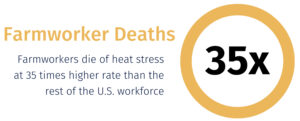
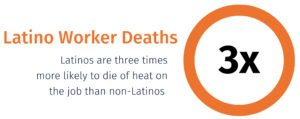
The Occupational Safety and Health Administration (OSHA) is responsible for protecting the safety and health of workers. Created by the Occupational Safety and Health Act of 1970 (OSH Act), the agency is tasked with promulgating rules to reduce hazards in the workplace and enforcing those rules by educating employers and holding employers accountable when they fail to put appropriate safety measures in place. For example, OSHA has developed rules to address workplace hazards such as lead, asbestos, infectious diseases, trenching cave-ins, fall risks, dangerous machinery and excessive noise. Unfortunately, despite the recommendations made over 50 years ago by the National Institute on Occupational Safety and Health (NIOSH) within the Centers for Disease Control and Prevention (CDC),[2] OSHA has yet to put a workplace heat hazard rule in place.
In 2021, in response to a petition submitted by Public Citizen and more than 100 organizations and experts, OSHA finally began working on a heat-safety standard.[3] However, the arduous process for developing a rule takes OSHA, on average, seven to eight years to complete.[4]
Congress has the power to protect workers now. The Asuncíon Valdivia Heat Illness, Injury and Fatality Prevention Act is a bill directing OSHA to institute an interim heat standard for indoor and outdoor workplaces until a final heat rule can be completed. This report describes why passing this legislation is essential.
Background
Despite the horrifying images of ever more brutal hurricanes, tornadoes and floods we frequently see in the news, extreme heat is the leading weather-related killer.[5] Globally, nearly half a million people die each year because of extreme heat.[6]
The ravages of the climate crisis are making environmental heat more dangerous with each passing year. Nine of the last 10 years have been the hottest on record. The summer of 2022 was the third warmest on record in U.S.[7] On just one day — Sep. 9, 2022 — nearly 1,000 heat records were broken in the U.S.[8]
The National Oceanic and Atmospheric Administration (NOAA), forecasts the El Niño climate phenomenon will return in the summer and fall of 2023,[9] bringing unprecedented extreme heat waves.[10] Climate models predict that 2023 will be hotter than 2022[11] and that 2024 will be the hottest year ever recorded.[12] The extreme outdoor heat will be accompanied by challenges in keeping indoor temperatures safe. The hot sun roasts buildings made with materials that absorb heat and lack proper cooling systems, causing indoor temperatures to swell beyond the outdoor temperature.
The human body has a complex regulatory system designed to keep our core temperature about 98.6 degrees. Heat stress refers to strain on that system as it tries to keep the body cool. Heat stress is a function of internally generated heat (metabolic heat), external environmental heat and other factors that reduce the effectiveness of our natural bodily cooling systems. The amount of physical effort needed for peoples’ workloads increases their metabolic heat production. The ambient temperature and radiant heat sources like direct sunlight and heat-generating machinery add to heat stress.[13]
Sweat is produced so that the process of evaporation can release body heat. But environmental conditions can severely limit the effectiveness of this cooling mechanism. High humidity reduces the evaporation of sweat. Very low humidity allows sweat to quickly evaporate and cool the body. But there is a limited amount of sweat the body can produce and, with extended exposure, sweating is reduced or ceases.[14]
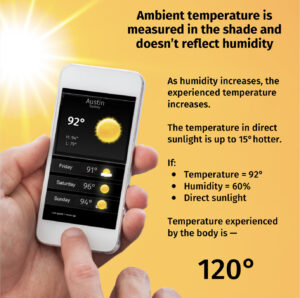 Pumping blood to the surface of the skin to be cooled by the surrounding air is another bodily cooling mechanism. But high environmental temperatures reverse the process, instead introducing more heat into the blood at the surface of the skin. In turn, the body works harder, pumping even more blood to the surface.
Pumping blood to the surface of the skin to be cooled by the surrounding air is another bodily cooling mechanism. But high environmental temperatures reverse the process, instead introducing more heat into the blood at the surface of the skin. In turn, the body works harder, pumping even more blood to the surface.
As more and more blood is diverted to the skin, less blood is being directed to the muscles and the brain[15] Without water replenishment, excessive sweating causes dehydration, thickening the blood and making the heart work harder.A greater proportion of the cardiac output is devoted to cooling the body and the portion available for physical and mental work decreases.[16] As the body’s cooling systems strain to keep the body cool, heat-related illness can occur.
Heat-related illnesses range in severity from mild heat rash to more severe illnesses such as rhabdomyolysis, acute kidney injury, heat stroke and heat-stress induced cardiac arrest. Workers who survive these more critical heat-related illnesses are often burdened with long term health effects, including muscle damage, organ damage and chronic kidney disease. Excessive heat in the workplace can also exacerbate existing chronic conditions like diabetes, COPD and cardiac disease, complicating the health care of these workers and potentially shaving years off their lives.
The symptoms of heat-related illnesses include heavy sweating, fatigue, nausea, headache, loss of balance and cognitive function, fainting, muscle cramps, and more. These symptoms can easily lead to accidents with a range of consequences to one or more people, including injuries, long-term disabilities or even fatalities.
Excessive Heat Takes an Exorbitant Toll on Workers
The Bureau of Labor Statistics (BLS) Census of Fatal Occupational Injuries indicates that 436 U.S. workers died from occupational heat stress between 2011 and 2021, an average of 40 per year.[17] We know this number grossly underestimates actual heat-related occupational fatalities. Determination of the cause of death relies primarily on the conclusions recorded in death certificates and the judgment of medical professionals making those findings.[18] This information is notoriously problematic in the case of heat stress because records may only indicate the immediate cause of death (e.g., kidney failure) without noting the underlying cause.[19] An extrapolation from research cross-referencing population fatality data with location-specific temperature data indicates that as many as 2,000 workers lose their lives to excessive heat in the workplace every year in the U.S.[20]
BLS estimates there were about 3,400 workplace heat-related injuries and illnesses requiring days away from work per year from 2011 to 2020.[21] However, this is a vast underestimate of the true impact on workers. BLS bases its conclusions on surveys of employers. This data is decidedly unreliable because it relies on self-reporting, and less than half of employers even maintain the required records.[22]
Data estimating injuries and illnesses from heat is further hampered by the difficulty of deeming “exposure to environmental heat” (the relevant BLS category) to be the chief cause out of hundreds of category choices when an injury or illness potentially caused by heat stress occurs.
Further, despite the use of the term “injuries and illnesses” in the categorization of heat-related worker harms by both BLS and OSHA, the data only reflect heat illnesses, not the injuries that are caused by the effects of heat stress. OSHA’s guidance on record-keeping regarding adverse outcomes from heat only references illnesses caused by excessive heat “such as heat illness, heat stroke, kidney injury and rhabdomyolysis.”[23] In reality, heat may be a determinative factor in many injuries. For example, heat stress may cause an employee to become dizzy and lose their balance, causing them to fall from a scaffolding or roof.
An analysis of more than 11 million worker’s compensation injury reports in California from 2001 through 2018 found that working on days with hotter temperatures likely caused about 20,000 injuries and illnesses per year in that state, alone — an extraordinary 300 times the annual number of injuries and illnesses the California OSHA (Cal/OSHA) attributes to heat.[24]
The results of the California study are instructive in estimating the extent of uncounted heat-related injuries nationwide. If California’s workers suffer approximately 20,000 heat-related injuries and illnesses per year, a simple extrapolation based on the worker population of other states suggests that the number suffered by all U.S. workers is likely in the range of 170,000 heat-related injuries and illnesses per year.[25]
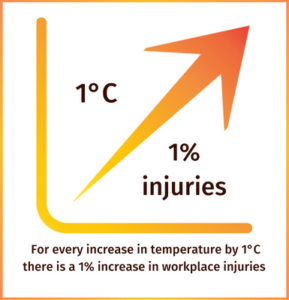 The extent of heat-related injuries in the workplace is further demonstrated by a meta-analysis of 17 studies worldwide that showed an average 1% increase in occupational injuries for every 1°C above 20.9°C (69.6° F). Increases were highest, up to 1.7% increase in injuries per 1°C, in humid subtropical climates, such as the southeastern parts of the U.S.[26] A study of agricultural workers in Washington State found the odds of traumatic injuries in cherry harvesters, primarily from ladder falls, increased 1.53% for every 1°C above 25°C (77° F).[27]
The extent of heat-related injuries in the workplace is further demonstrated by a meta-analysis of 17 studies worldwide that showed an average 1% increase in occupational injuries for every 1°C above 20.9°C (69.6° F). Increases were highest, up to 1.7% increase in injuries per 1°C, in humid subtropical climates, such as the southeastern parts of the U.S.[26] A study of agricultural workers in Washington State found the odds of traumatic injuries in cherry harvesters, primarily from ladder falls, increased 1.53% for every 1°C above 25°C (77° F).[27]
Improvements in tracking the impact of heat stress on workers are desperately needed. However, it’s clear that a dramatic number of workers suffer serious consequences of heat stress. This is a burden that takes a disproportionate toll on workers that are living in poverty, low-income, Black or Brown.[28]
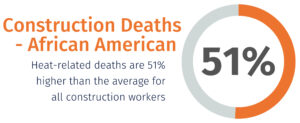
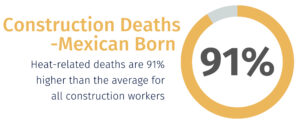
Importantly, the California study of workers’ compensation claims from 2001 to 2018 found that the increase in injuries on hot days was cut by approximately 30% in the years following California’s issuance of a state occupational heat standard in 2005.[29] Therefore, a federal standard similar to California’s heat standard would prevent more than 50,000 heat-related injuries annually. Moreover, California’s limited standard only covers outdoor workplaces[30] and exempts numerous industries from implementing high-heat procedures.[31] It is also less protective in other key ways than the more recent, and well-informed standard issued by Oregon OSHA.[32] A strong, comprehensive federal standard covering both outdoor and indoor workplaces could prevent significantly more injuries and fatalities.
Financial Cost of Failure to Mitigate Workplace Heat Stress Hazards
There are multiple ways employers can mitigate heat stress in the workplace. The simplest of these is providing workers with consistent access to cool drinking water and adequate “cool down” breaks in a shaded or air-conditioned space. Acclimatizing new employees to working in high heat conditions over multiple days is another important strategy to protect workers. Employers can make a variety of simple alterations such as heat shields for indoor workers stationed next to heat-generating machinery or awnings over windows to block the sunlight. Employers can also increase ventilation or air conditioning in inside workspaces. While these physical alterations may involve more up-front costs, they are the most effective in reducing the impact of heat stress on these indoor workers.
The price paid by workers of failing to implement heat stress mitigation strategies is incalculable and unacceptable. The heavy toll includes financial hardships, but more importantly, the loss of health, safety, and life. Though it’s not possible to weigh lives against any costs to employers of putting safety measures in place, it is important to understand the financial impact of implementing an OSHA heat standard.
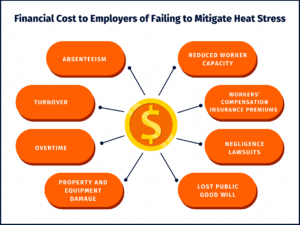 Employers often raise knee-jerk concerns about the costs of these heat hazard mitigation strategies. However, the financial cost of failing to mitigate heat stress is much higher. Employers face reduced productivity resulting from absenteeism and turnover when workers experience heat-related illness or injury, as well as general reduced worker capacity because of heat stress. Employers may have to pay for overtime to replace absent workers. They may be straddled with the cost to repair or replace damaged equipment, vehicles and property owing to accidents caused by heat stress. Workers’ compensation premiums may increase due to the number of claims by injured workers. By not addressing an obvious risk of worker heat-related illness or injury, an employer may be sued for negligence and forced to pay court judgements and associated legal fees. A reputation as an unsafe workplace also means the potential loss of the public goodwill and, with it, customers. The OSHA $afety Pays tool estimates the average direct costs of a single “heat prostration” injury in the workplace to be $37,658 with an estimated indirect cost of $41,423.[33]It also estimates average syncope (fainting) direct costs at more than $30,000 and indirect costs exceeding $33,000.[34] In general, heat stress prevention is cheaper than responding to the consequences of a tragedy.
Employers often raise knee-jerk concerns about the costs of these heat hazard mitigation strategies. However, the financial cost of failing to mitigate heat stress is much higher. Employers face reduced productivity resulting from absenteeism and turnover when workers experience heat-related illness or injury, as well as general reduced worker capacity because of heat stress. Employers may have to pay for overtime to replace absent workers. They may be straddled with the cost to repair or replace damaged equipment, vehicles and property owing to accidents caused by heat stress. Workers’ compensation premiums may increase due to the number of claims by injured workers. By not addressing an obvious risk of worker heat-related illness or injury, an employer may be sued for negligence and forced to pay court judgements and associated legal fees. A reputation as an unsafe workplace also means the potential loss of the public goodwill and, with it, customers. The OSHA $afety Pays tool estimates the average direct costs of a single “heat prostration” injury in the workplace to be $37,658 with an estimated indirect cost of $41,423.[33]It also estimates average syncope (fainting) direct costs at more than $30,000 and indirect costs exceeding $33,000.[34] In general, heat stress prevention is cheaper than responding to the consequences of a tragedy.
Employers sometimes raise concerns about the cost of lost productivity when providing needed breaks to workers from high temperatures. However, heat stress reduces the physical and mental capacity for work. Without heat stress mitigation, such as opportunities to rest in a cool area and drink water, heat stress continues to increase and worker capacity decreases, ultimately reaching a point when work is no longer physically possible.
As noted above, the strain to keep the body cool causes fatigue, deficits in motor and cognitive function, dizziness, nausea, cramps and other symptoms of heat-related illness that become increasingly severe. Even the earliest symptoms of heat stress limit the ability to function, interfering with worker effectiveness and increasing the risk of mistakes, accidents and injuries. A meta-analysis of seven studies in multiple countries found that worker productivity declines averaged 2.6% per degree Celsius above a Wet Bulb Globe Temperature (WBGT)[35] of 24°C (75.2°F).[36]
Foster et al. developed a model to predict the reduction in work capacity associated with increases in ambient temperature and relative humidity (see Figure 1).[37] The model predicts, for example, that a worker is able to work at close to full capacity when it’s 77°F with a relative humidity of 30%.[38] However, worker capacity drops dramatically as temperatures and humidity rise. Worker capacity drops to 25% when the temperature reaches 104°F with a relative humidity of 80%.[39] This is the equivalent of only working 15 minutes each hour.[40]
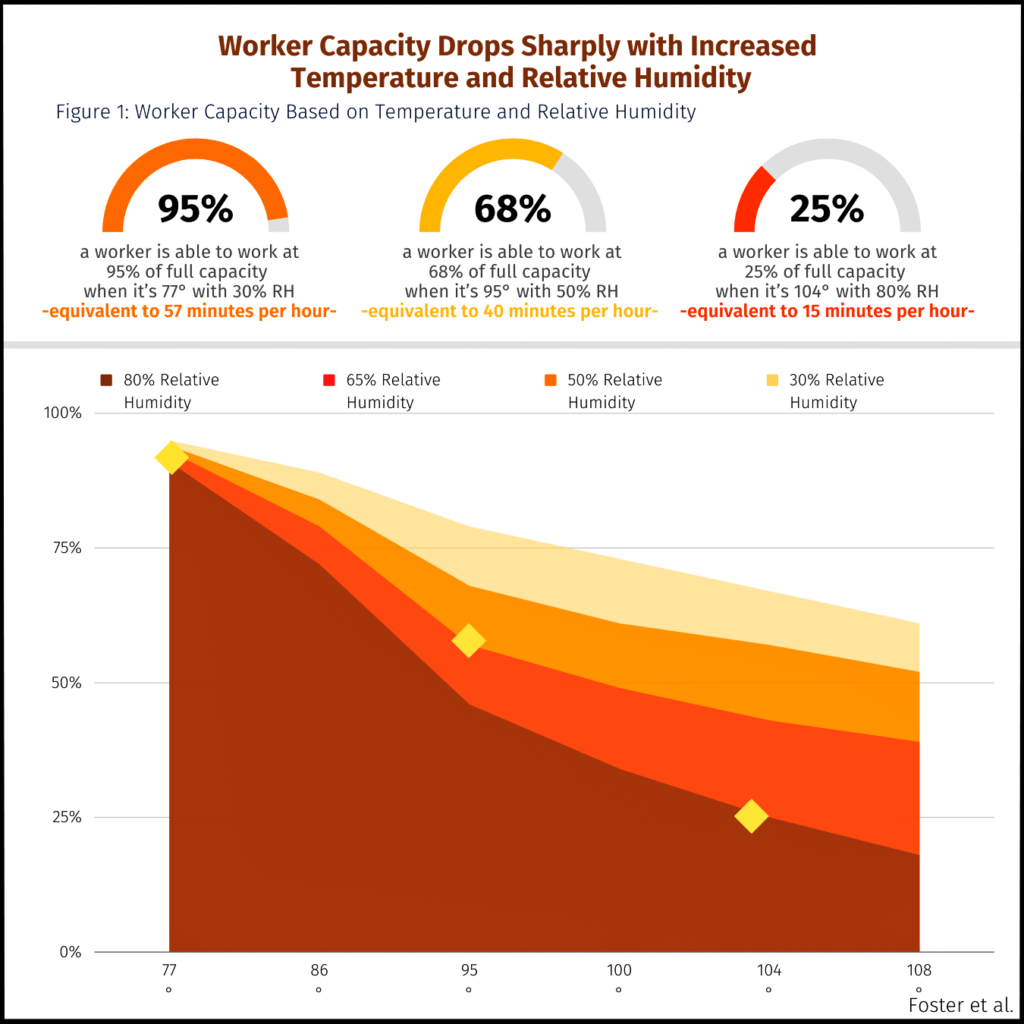
Clearly, concerns about lost worker productivity with increased breaks in high temperatures are misinformed. Increased breaks don’t just protect workers from heat stress, they improve worker productivity.
Lost worker capacity due to heat stress doesn’t just impact an individual employer’s bottom line. It has a tremendous impact on the economy as well. It is estimated that the annual global cost of lost work time due to reduced worker capacity due to unmitigated heat stress is $2.1 trillion.[41] The U.S. alone is losing more than $98 billion every year.[42]
In the United States, 62% of all counties annually lose more than 0.5% of gross value added (GVA) due to heat-related worker productivity losses.[43] The GVA is a productivity measure reflecting the value of goods and services produced in the area, industry or sector derived as the output minus immediate consumption. Productivity losses are greater than $5 million per year in approximately the same percentage of counties.[44] Texas counties lose a combined $30 billion in a typical year, the equivalent of about 1.5% of GVA in those counties, on average, and Florida loses $11 billion per year.[45] It is no surprise that, by proportion, the productivity losses are greatest in agriculture and construction.[46] And, because many indoor businesses lack air conditioning or adequate ventilation, the services sector sustains the greatest overall losses.[47] This includes restaurants, transportation, hospitality, and warehousing.[48]
As we consider all of these costs, it becomes apparent that there is no conflict between worker safety and business profitability. It is in the best interests of everyone that safety measures against heat hazards in the workplace be implemented.
Why Do We Need an OSHA Interim Heat Standard?
Even with the obvious benefits of implementing safety strategies to reduce worker heat stress, some employers will choose not to do so. Absent a standard specifically focused on heat, OSHA has limited means to press those employers to mitigate heat hazards in the workplace. Currently, in order to hold an employer accountable for an excessive heat hazard, OSHA must rely on the General Duty Clause of the OSH Act, which calls for employers to furnish their employees with conditions that are free of hazards “that are causing or are likely to cause death or serious physical harm to his employees.” But taking enforcement action pursuant to the General Duty Clause is time-consuming and often vulnerable to legal challenges. Several rulings since 2018 of the Occupational Safety and Health Review Commission (OSHRC), an administrative court, highlight the limits of the General Duty Clause.
For example, an OSHRC Administrative Law Judge (ALJ) issued five substantially identical decisions in similar cases in which OSHA alleged the United States Postal Service, in multiple locations, exposed its employees to unmitigated excessive heat as they delivered the mail. In each case, the ALJ vacated OSHA’s citation, finding that OSHA had not met its burden to establish that a condition in the workplace presented a hazard, even in the face of evidence of heat indices as high as 109°F and workers medically diagnosed with heat illnesses.[49]
The ALJ, noted that “without a temperature- or heat index-specific standard, it is difficult for employers to know when heat is ‘excessive,’”[50] and referenced OSHA’s failure to provide such a standard, stating, “OSHA has been urged to promulgate a heat stress standard since shortly after the [OSH] Act went into effect.”[51]
On appeal, the Commission disagreed with the ALJ, finding that OSHA had presented sufficient evidence of an excessive heat hazard. However, one Commissioner, of the two-Commisioner panel, emphasized that the decision did not itself “establish [] any sort of criteria for determining when ‘excessive heat,’ may be present,” suggesting that would “presumably be accomplished by the Secretary’s” promulgation of “an OSHA standard.”[52]
A heat standard will ensure OSHA has the ability to hold employers accountable when they put workers in danger of heat illness, injury and death. Moreover, it will provide clear guidance to employers on what actions are necessary to meet the universal requirement to provide a workplace free of dangerous heat hazards. Delay in putting a heat standard in place hinders the ability of OSHA to carry out its congressional directive to ensure workers are protected from dangerous working conditions, making it essential to establish an interim standard now.
Conclusion
Every year in the United States as many as 2,000 workers lose their lives to excessive heat in the workplace[53] — a price no worker should ever have to pay. The impact of these lost lives on their families and loved ones is immeasurable. Up to 170,000 additional workers are injured in heat stress related accidents on the job,[54] potentially resulting in long-term disabilities that can not only diminish worker income, but also have detrimental effects on worker health and reduce quality of life.
Each year without an OSHA heat stress standard puts the health and lives of more workers on the line. The risk of workplace heat stress illness, injury and death is increasing with climate change and predictions for extreme temperatures and increased heat waves in 2023 and 2024 make the need for a heat standard more urgent than ever.
Because it’s impossible to put a price on lost lives, human suffering or the workers’ fears that they may not return home due to injury, there is no acceptable cost-benefit analysis to determine whether employers should implement basic protocols that protect workers from heat-related illness, injury, and death. Nor should there be. Still, it is important to understand the cost of inaction and delay. The burden of occupational heat stress on the economy is tremendous and rapidly growing. Failing to mitigate the hazard for workers has great financial consequences for employers. Yet, simple and affordable solutions exist to both protect workers and benefit employers.
A comprehensive federal standard covering heat hazards in indoor and outdoor workplaces (see Appendix) would prevent more than 50,000 heat-related injuries annually. Congress has the opportunity to direct OSHA to put an interim heat standard in place that would safeguard employees now from deadly heat by passing the Asuncíon Valdivia Heat Illness, Injury and Fatality Prevention Act. Congress must pass the bill with all haste to protect workers while a final OSHA rule is promulgated.
Appendix
What Should Be in An OSHA Rule To Prevent Heat Illness, Injury, And Death?
Every workplace injury and fatality caused by heat stress is avoidable, and relatively simple preventative measures have proven extremely effective at protecting workers. It is both the social and legal responsibility of employers to create a work environment safe from heat hazards.
OSHA should create a heat standard delineating required preventative measures that include the following:
Temperature Thresholds: An OSHA heat standard must provide clarity to employers and workers in order to ensure effective comprehension and implementation of the standard. This is particularly important for small businesses, where reliance on complicated formulas for decision-making may be cumbersome. Identifying clear temperature thresholds, including thresholds for high heat and extreme heat, that trigger certain minimum employer requirements under the standard will protect both workers and employers.
Workload and Pace: Employers should empower workers to work at their own pace whenever possible. Workload should be reduced or suspended in times of extreme temperatures.
Mandatory Rest Breaks: Employers should be required to give workers a 15-minute break for every two hours of work when the temperature exceeds 80 degrees. Scheduled breaks should increase with temperatures based on the work/rest schedule recommended by NIOSH with an adjustment for clothing and PPE. Workers should be permitted and encouraged to take unscheduled breaks when they feel overheated or experience any symptoms of heat illness.
Indoor and Outdoor Cooling: Indoor workplaces should be air-conditioned or well-ventilated to keep temperature below 80 degrees. Or, at a minimum, include a cool space for breaks. Delivery trucks should be air conditioned whenever possible. Outdoor workplaces should provide a cool, shaded space for breaks.
Hydration: Employers should be required to provide workers at least one liter of cold drinking water every hour. Water should be easily accessible and, preferably made continuously available. With very heavy workloads at high temperatures workers also should be provided drinks with electrolytes.
Heat Stress Plan: Each employer should use the information available from OSHA, NIOSH, industry-specific guidance and other expert sources to create a written heat stress plan that is appropriate for use at their unique worksites. The plan should be comprehensive and available to employees in a language they can understand.
Emergency Response: Employers should be required to have an emergency action plan (EAP) that includes training personnel to identify workplace heat illnesses and to provide appropriate cooling strategies at each worksite. Designated employees or managers should be trained in specific workplace medical responses. The EAP should include information on when to call an ambulance, including guidance to call an ambulance when in doubt.
Heat Acclimatization Plan: All workers beginning work in high-heat environments, or who will be working in hotter conditions than usual (e.g., during a heat wave), must be gradually acclimatized to the work over a period of at least 7 to 14 days.
Environmental Surveillance and Hazard Notification: At outdoor worksites, employers should be required to monitor environmental conditions at each worksite and notify employees of hazardous heat conditions in English and any languages spoken by at least 20% of workers.
Worker Information and Training: Employers must be required to provide all employees with heat stress training when they are hired, as well as annually in the employees’ primary language.
Record Keeping: Employers should be required to maintain and properly handle accurate records of: 1) heat illnesses, including those treated onsite with first aid; 2) accidents or injuries potentially related to heat strain, including recording the workplace temperature and protective clothing and gear worn by the worker for every workplace injury; 3) environmental and metabolic heat exposures; 4) acclimatization procedures; 5) all medical and physiological monitoring; and 6) modifications to engineering and administrative controls, as well as changes to personal protective equipment.
Non-retaliation Policy: An OSHA heat standard must include comprehensive whistleblower rights so that workers are vigorously protected from all forms of employer retaliation for reporting unsafe conditions that could lead to heat illness or injury.
[1] All about OSHA, Occupational Safety and Health Administration, U.S. Department of Labor, OSHA 3302–02R 2023, https://www.osha.gov/sites/default/files/publications/all_about_OSHA.pdf.
[2] Criteria for a Recommended Standard: Occupational Exposure to Hot Environments, National Institute of Occupational Safety and Health, U.S. Depart of Health, Education and Welfare (1972), https://bit.ly/3MMhfDE.
[3] Heat Injury and Illness Prevention in Outdoor and Indoor Work Settings, 86(205) Federal Register 59309 (Oct. 27, 2021), https://bit.ly/3dosuj7. Public Citizen and more than 100 allied organization and occupational heat experts filed petitions with OSHA for an occupational heat standard in 2011 and 2018, as well as a petition for an Emergency Temporary Standard in 2021. Petitions to OSHA for a Heat Standard, Public Citizen, https://bit.ly/3HHqu3G.
[4] Workplace Safety and Health: Multiple Challenges Lengthen OSHA’s Standard Setting, U.S. Government Accountability Office (April, 2012), https://bit.ly/3N8oHG3.
[5] Jonathan Erdman, America’s Top Weather Killer is Not Tornadoes, Flooding, Lightning or Hurricanes – It’s Heat, The Weather Channel (June 21, 2022), https://weather.com/safety/heat/news/2021-06-03-heat-america-fatalities.
[6] Qi Zhao, Yuming Guo, Tingting Ye, Antonio Gasparrini, Shilu Tong, Ala Overenco et al., Global, Regional, and National Burden of Mortality Associated with Non-optimal Ambient Temperatures from 2000-2019: A Three-Stage Modeling Study, 5(7) The Lancet Planetary Health E415-E425 (July 1, 2021), https://bit.ly/3tlLPZB.
[7] Allison Finch, Summer of 2022 Ranks as Third Warmest on Record For Contiguous US, Accuweather (Sep. 13, 2022), https://bit.ly/3t9UcYP.
[8] National Oceanic and Atmospheric Administration (NOAA) (accessed May 19, 2023), https://www.ncdc.noaa.gov/sotc/national/202209.
[9] ENSO: Recent Evolution, Current Status and Predictions, NOAA (March 13, 2023 ), http://bit.ly/3TRgOK6.
[10] Damian Carrington, Warning of Unprecedented Heat Waves as El Niño Set to Return in 2023, The Guardian ( January 16, 2023 ), http://bit.ly/3TRNW4i.
[11] Dana Nuccitelli, 2022 Was a Remarkable Year for the Climate. Here’s What to Expect in 2023, Yale Climate Connections (January 9, 2023), http://bit.ly/3nwDJ1n.
[12] Carrington, Warning of Unprecedented Heat Waves as El Niño Set to Return in 2023.
[13] Recommended Heat Standard: Occupational Exposure to Heat and Hot Environments, National Institute of Occupational Safety and Health, Centers for Disease Control and Prevention (2016), https://bit.ly/3ivb7sd.
[14] S. Tony Wolfe, Rachel, M. Cottle, Daniel J. Vecellio, and W. Larry Kenney, Critical Environmental Limits For Young, Healthy Adults (PSU Sheet Project), Journal of Applied Physiology (December 16, 2021), https://bit.ly/3WfWkfp.
[15] Josh Foster, James W. Smallcombe, Simon Hodder, Ollie Jay, Andreas D. Flouris, Lars Nybo and George Havenith, An Advanced Empirical Model for Quantifying the Impact of Heat and Climate Change on Human Physical Work Capacity, 65 International Journal of Biometeorology 1‐15 (2021), https://bit.ly/3xT1FhG [hereinafter Foster et al., Quantifying Impact of Heat on Work Capacity (2021)]; Margaret C. Morrissey, Gabrielle J. Brewer, Tyler Quinn and Douglas J. Casa, Impact of Occupational Heat Stress on Worker Productivity and Economic Cost, American Journal of Industrial Medicine (Sep. 2021), https://bit.ly/3RdM2YQ.
[17] Census of Fatal Occupational Injuries (2011-forward), BLS (accessed May 4, 2023), https://bit.ly/3NzjvvV. Annual estimates were retrieved by selecting Area — “All U.S.,” Case type — “Fatalities in all sectors,” Category — “E5A Event or exposure — exposure to environmental heat,” and Industries — “000000 All Workers.”
[18] The BLS Census of Occupational Injury (CFOI) collects multiple source documents, because each work-related death must be confirmed by at least two sources. Of the source documents collected, death certificates are collected on all deaths and medical examiner/autopsy/coroner reports are commonly collected. Other sources may serve as confirmation, such as toxicology, OSHA or workers’ comp reports, and even the news media. Census of Fatal Occupational Injuries: Data Sources, BLS (accessed on June 12, 2022), https://bit.ly/3OcqN8U. The CFOI examines all cases where the death certificate is marked “At work” and, additionally, occupational illness reports from OSHA to determine if there was an injury component to the illness. Scope of the Census of Fatal Occupational Injuries (CFOI), BLS (accessed on June 13, 2022), https://www.bls.gov/iif/cfoiscope.htm.
[19] Technical Documentation: Heat Related Deaths, Environmental Protection Agency (accessed on June 8, 2022), https://bit.ly/3mvfRY5.
[20] See, Juley Fulcher, Boiling Point: OSHA Must Act Immediately to Protect Workers from Deadly Temperatures, Public Citizen (June 2022), https://www.citizen.org/article/boiling-point/ [hereinafter Fulcher, Boiling Point (June, 2022)].
[21] Nonfatal Cases Involving Days Away from Work: Selected Characteristics (2011 forward), BLS (accessed May 2, 2023), https://bit.ly/38YK8LP. Annual estimates were retrieved by selecting Area — “All U.S.,” Ownership — “All ownerships,” Data Type — “Injury and illness cases,” Case type — “Industry division or selected characteristic by detailed event or exposure,” Category — “00X All Industry,” and Event or Exposures — “531XXX Exposure to environmental heat.”
[22] Elizabeth Rogers, The Survey of Occupational Injuries and Illnesses Respondent Follow-Up Survey, Monthly Labor Review, Bureau of Labor Statistics (May 2020), https://bit.ly/2UukCqo.
[23] Heat, Related Standards, OSHA (accessed on May 19, 2023), https://bit.ly/3z5CB5x.
[24] R. Jisung Park, Nora Pankratz & A. Patrick Behrer, Temperature, Workplace Safety, and Labor Market Inequality, IZA Institute of Labor Economics DP No. 14560 3 (July 2021), https://bit.ly/2V3WriI [hereinafter R. Jisung Park et al., Temperature, Workplace Safety, and Labor Market Inequality, 2021].
[25] Fulcher, Boiling Point (June, 2022).
[26] Syeda Hira Fatima, Paul Rothmore, Lynne C. Giles, Blesson M. Varghese and Peng Bi, Extreme Heat and Occupational Injuries in Different Climate Zones: A Systematic Review and Meta-analysis of Epidemiological Evidence, 148 Environment International 106384 (March, 2021), https://bit.ly/3jGUEcL.
[27] June T. Spector, David K. Bonauto, Lianne Sheppard, Tania Busch-Isaksen, Miriam Calkins, Darrin Adams, Max Lieblich and Richard A. Fenske, A Case-crossover Study of Heat Exposure and Injury Risk in Outdoor Agricultural Workers, Plos One (Oct. 7, 2016), https://bit.ly/2ZQLxiz.
[28] See, Fulcher, Boiling Point (2022), https://bit.ly/3tfFlff.
[29] R. Jisung Park et al., Temperature, Workplace Safety, and Labor Market Inequality (2021), 5.
[30] On March 31, 2023, the California Occupational Safety and Health Standards Board has proposed adoption of a “Heat Illness Prevention in Indoor Places of Employment” provision to the California Code of Regulations, https://bit.ly/3OoXgMt.
[31] Cal. Code. Regs., tit. 8, § 3395 , Heat Illness Prevention in Outdoor Places of Employment (enacted in 2005), http://bit.ly/3p0xOy7..
[32] Or. Admin. R. §437-002-0156 and §437-004-1131, Heat Illness Prevention (enacted in 2022).
[33] OSHA’s $afety Pays, OSHA (accessed on Sep. 26, 2022), https://bit.ly/3xRlZQE.
[35] The Wet Bulb Globe Temperature (WBGT) measures heat impact on the body by combining ambient temperature, relative humidity, air movement (wind speed) and solar radiant heat (e.g., heat-generated machinery, sunlight angle and cloud cover). It is a more accurate measure for calculating workplace heat stress than than the heat index. The heat index is a measure of apparent heat in the shade and as much as 15°F must be added to the heat index to get a measure of heat impact on the body in direct sunlight.
[36] Andreas D. Flouris, Petros C. Dinas, Leonidas G. Ioannou, Lars Nybo, George Havenith, Glen P. Kenny and Tord Kjellstrom, Workers’ Health and Productivity Under Occupational Heat Strain: Systematic Review and Meta-Analysis, 2(12) The Lancet Planetary Health E521-E531 (Dec. 1, 2018), https://bit.ly/3DRPl2z.
[37] Foster et al., Quantifying Impact of Heat on Work Capacity (2021).
[38] See, Juley Fulcher, The Cost of Inaction: The Failure of Employers to Mitigate the Effects of Heat Stress on Workers Causes Preventable Heat-related Illness, Injury and Fatalities and Costs the Economy Nearly $100 Billion Each Year, Public Citizen (Oct. 4, 2022), https://bit.ly/3WeMgTX. Research has shown that the optimal work environment for 100% productivity is between 59°F and 65%F.
[40] The Foster et al. model is likely a conservative estimate as it fails to include the the impact of solar radiation for those working outside in the sun, a significant factor in causing heat stress. Another study found that worker productive loss in the shade was 80% lower than productivity loss of those working in the sun. Marco Morabito, Alessandro Messeri, Alfonso Crisci, Junzhe Bao, Rui Ma, Simone Orlandini, Cunrui Huang and Tord Kjellstrom, Heat-Related Productivity Loss: Benefits Derived by Working in the Shade or Work-Time Shifting, 70(3) International Journal of Productivity and Performance Management507-525 (2021), https://bit.ly/3UE7A3P.
[41] Luke A. Parsons, Yuta J. Masuda, Timm Kroeger, Drew Shindell, Nicholas H. Wolff and June T. Spector, Global Labor Loss Due to Humid Heat Exposure Underestimated for Outdoor Workers, 17(1) Environmental Research Letters 014050 (2022), https://bit.ly/3DXvrWn [hereinafter Parsons et al., Global Labor Loss Due to Heat Exposure (2022)]. Purchasing Power Parity dollars (PPP$) is a measure to compare prices of goods between countries. In this study, the 2017 cost of lost labor due to the limits in worker capacity resulting from measures of heat and humidity was estimated for each country in their local currency. Each estimate was divided by the country’s GDP 2017 PPP conversion rate to U.S. dollars as determined by the World Bank .The sum of each national estimate is the global estimate of lost labor due to the limits in worker capacity resulting from measures of heat and humidity.
[42] Parsons et al., Global Labor Loss Due to Heat Exposure (2022).
[43] Atlantic Council: Adrienne Arsht Rockefeller Foundation Resilience Center and Vivid Economics, Extreme Heat: The Economic and Social Consequences for the United States (August, 2021), https://bit.ly/3D8FGDA. Only a handful of Alaskan counties currently have no economic losses.
[49] Juley Fulcher, OSHA Fails to Protect Workers From Extreme Heat Hazards: OSHRA Decisions Demonstrate the Need for an OSHA Heat Stress Standard, Public Citizen (2020), https://bit.ly/3tztdGO.
[50] Secretary of Labor v. United States Postal Service, National Association of Letter Carriers (NALC) and National Rural Letter Carriers’ Association (NRLCA), OSHRC Docket Nos. 16-1713, https://bit.ly/3zY8EHX; 16-1813, https://bit.ly/39LQdf1;
16-1872, https://bit.ly/3NeBsyT; 17-0023, https://bit.ly/3bo2XJc; 17-0279, https://bit.ly/3xNO0Yf (July 15, 2020).
[52] Secretary of Labor v. United States Postal Service, OSHRC Docket Nos. 16-1713, 16-1872, 17-0023, 17-0279 (Feb 17, 2023), https://bit.ly/432vbik.. On this point, the decision referenced Kastalon, Inc., 12 BNA OSHC 1928, 1928-29 (No. 79-5543, 1986) (consolidated) (“Congress intended that the Secretary would primarily rely on specific standards, rather than the broad mandate of the general duty clause, to seek the correction of workplace hazards.”) and Reich v. Arcadian Corp., 110 F.3d 1192, 1196 (5th Cir. 1997) (“Courts have held that enforcement through the application of standards is preferred because standards provide employers notice of what is required under the OSH Act.”). Id. at 5, note 7.
[53] Fulcher, Boiling Point (June, 2022).